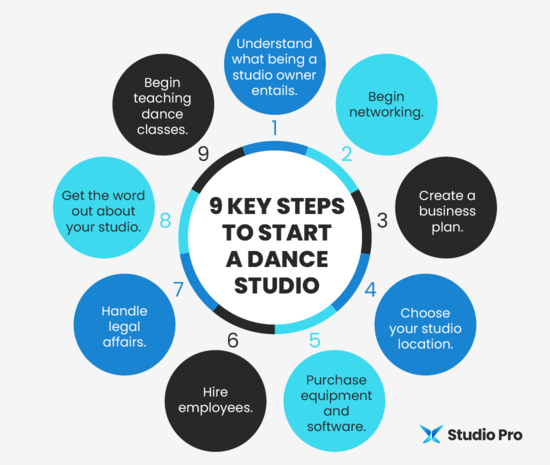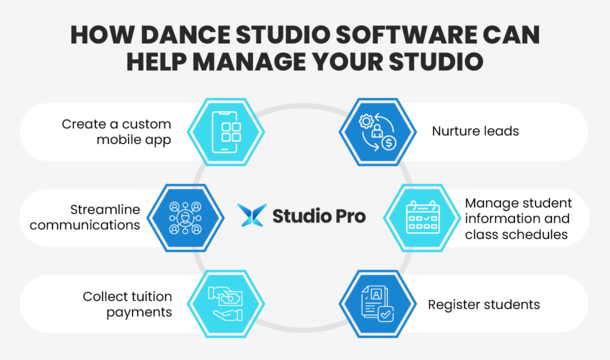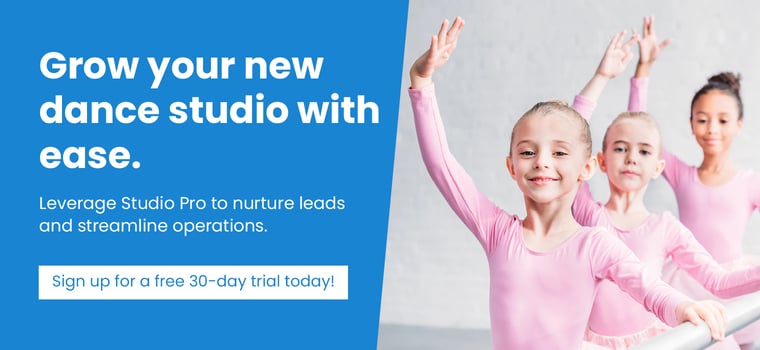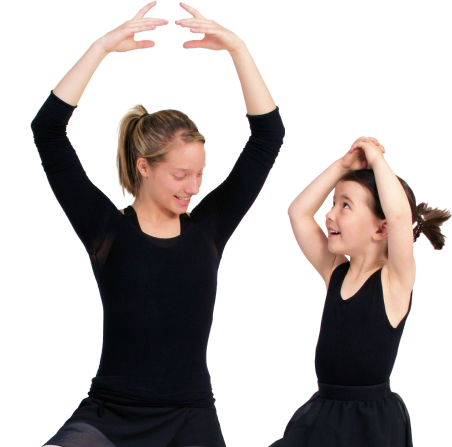So, you’ve decided to take your love of dance to the next level and start your very own dance studio. You might be a lifelong dancer who wants to share a love of dance with a wider community, or maybe you always dreamed of starting your own business and being your own boss.
Whatever the case is, you must turn your ideas into concrete steps to bring your dance studio to life. By following these steps, you can build your business from the ground up and be confident and prepared when it comes time to teach your first classes:
- Unerstand what being a studio owner entails.
- Begin networking.
- Create a business plan.
- Choose your studio location.
- Purchase equipment and software.
- Hire employees.
- Handle legal affairs.
- Get the word out about your studio.
- Begin teaching dance classes.
.png?width=1520&height=440&name=How%20to%20Start%20a%20Dance%20Studio_Skinny%20CTA%20(1).png)
9 Key Steps to Start a Dance Studio

1. Understand what being a studio owner entails.
Before starting your own dance studio, ensure you have sufficient teaching or managerial experience so you know what you’re getting into. Reach out to friends in the industry or other studio owners you know and ask questions about their experiences running studios. You might ask:
- How many hours do you typically work in a week?
- How long did it take you to feel established with your business?
- What are the biggest challenges you face in your role?
- What do you enjoy most about your role?
- What advice would you give to someone starting their own studio?
Keep track of all your observations and advice received during this time to incorporate into your business plan. Consider asking fellow studio owners if they’d be willing to let you shadow them for a day or two so you can immerse yourself in the daily tasks associated with running your own studio.
2. Begin networking.
Reach out to industry professionals you respect and admire who can guide you in the right direction as you start your studio journey. These professionals can offer advice, resources, and a helping hand later on when you start promoting your business.
Look beyond your local dance studios to connect with studio owners from all over to build your network and seek the best advice. You might feel shy at first reaching out to a total stranger, but remember: the dance community is generally made up of friendly, open people willing to lend a hand because everyone has the same goal of bringing more people into the dance world.
You can reach out to studio owners via:
- Social media
- Their websites
- Networking platforms like LinkedIn
Open with a friendly, professional greeting and get right to the point: you’re starting a dance studio and you’d appreciate their advice. The worst they can do is not respond, but if they do, you’ll gain valuable insight into the dance industry from someone who’s already navigated the waters before you.
3. Create a business plan.
Now that you’ve completed your pre-planning, it’s time to get down to the nitty-gritty and write your business plan. A detailed, thorough business plan will act as a roadmap to guide you throughout the rest of the planning process for bringing your dance studio to life. Here’s what you need:
 Executive summary
Executive summary
An executive summary is an outline of your entire business plan that appears at the beginning of the plan. The executive summary should:
- Summarize your business’s mission
- Detail your personal motivations for starting your own studio
- Explain your future vision for your studio
Although the executive summary appears first in your business plan, it’s a good idea to write it last once you’ve determined the details of your plan’s other sections.
Company description
Provide a high-level overview of your business with each of the following characteristics:
- A brief synopsis of why you decided to start the business and a quick introduction of yourself as the owner
- The classification of your business (partnership, corporation, etc.)
- The services and/or products you will provide and the audience you’re catering to
- How many employees you’ll have
- How your business will differentiate itself in the marketplace to make a profit
Products and services
Here’s where you’ll get specific about what your dance studio will offer. This section should answer questions like:
- Will you host private and group lessons?
- Will you serve all ages or specific groups, such as just ages 18 and under?
- Will your studio include a shop to purchase dance equipment, costumes, or accessories?
Figure out what exactly you’re offering and provide a breakdown of your goods and services here. Additionally, focus on how these offerings will serve your target audience better than your competitors do. Be direct about how your dance studio will reach an underserved population or fill a specific niche in your local market.
Market analysis
In this section, prove your expertise in your field by providing a comprehensive overview of the current state of the dance industry, including:
- Customer demographics
- The past and projected future of the dance market
- Needs in the market
- Competitor descriptions
Add any necessary data and statistics to paint a clear picture of how your studio will not only fit into this market but thrive in the dance space.
Marketing strategy and implementation
Now that you’ve identified the needs in the market, explain how your studio will serve those needs through your sales and customer acquisition strategy. How will you bring on new students and keep them coming back to your studio? Will you use paid social media ads, a website, ads on local radio and TV stations, billboards, or flyers? Nail down these details early on to create a clear plan to accomplish your marketing goals.
Additionally, discuss how you plan to retain these customers to grow your business. How will you keep customers engaged and satisfied with your services? Answer these questions and list any specific strategies you plan to use.
Management and organization
Summarize how your company will be structured, including how many employees you expect to hire and who will be on your management team. Describe the individual qualifications needed for each role and their specific responsibilities.
Financial plan and projections
Finally, provide information about your dance studio’s financial framework. Evaluate business costs and future projected earnings based on market trends. You might also include income statements, balance sheets, and cash flow statements in this section.
4. Choose your studio location.
Next, you can start searching for a home for your new dance studio. Consider the following when choosing a property:
- Location: Is the building central to major populated areas? Is the surrounding area pleasant, with other businesses or shops nearby?
- Price: Does the property fall within your budget? Will you have to take out any loans?
- Convenience: Is the location easy to get to, with enough parking spots? Is it close to where you live, or will you have a long commute?
- Aesthetics: Does the space offer enough room for classes and other activities? Are there amenities such as a break room or kitchen for staff?
Narrow down the list of acceptable options in your area, and choose the one with the most positive qualities.
5. Purchase equipment and software.
One of the best things you can do to set yourself up for success with your new dance studio is to invest in the right equipment and studio management software early on. Top-quality equipment will save you from endlessly having to replace broken or worn-out items, and your dance studio management software will be the backbone of your management strategy.
Dance studio equipment
Purchase all of the necessary equipment to fully furnish your studio, including:
- Floor-length mirrors
- Durable flooring
- Barres
- A stereo system
Additionally, purchase any managerial equipment such as a desk, computer, and tablets for taking attendance or accepting payments.
Dance studio software
In addition to fulfilling your physical studio needs, take the time to research and invest in high-level dance studio software. Powerful dance management software like Studio Pro will allow you to manage every aspect of your studio in one digitized system. With a platform like Studio Pro, you can:

- Nurture leads. Dance studio software makes it easy to follow up with leads so you can grow your business. Automate communications based on where leads are in your pipeline, and track progress in your leads dashboard.
- Manage student information and class schedules. Keep track of all important student information, such as attendance, medical information, and their progress in classes. Your dance studio software can also manage class scheduling and instructor assignments.
- Register students. Online registration forms make it easy and convenient for students and parents to sign up for classes. You can set up automated multi-student discounts, registration fees, and promotions, and limit sign-ups based on age and class capacity.
- Collect tuition payments. Accept payment via credit card, direct deposit, eCheck, and ACH. Leverage Auto-Pay to eliminate the stress of tracking down missing payments.
- Streamline communications. Use your studio management software to segment message recipients into different groups and send out mass reminders and updates via email, text messages, and push notifications.
- Create a custom mobile app for your studio. With your mobile app, your students, teachers, and staff can access class schedules, make online payments, and more—all in one convenient location.
Your dance studio management software will provide the digital infrastructure you need to simplify and organize your management procedures and store all the information you need in one spot from the beginning.

6. Hire necessary employees.
As a new business, you’ll want to keep your payroll small to be profitable, but hiring one or two additional instructors can help spread out the workload and ensure smoother sailing as you get started. You’ll want to add team members who will accurately carry out your vision and contribute to a positive studio culture.
First, look for people you may already know who would be a good fit for your studio and are interested in the position. These could be dance friends or other people you’ve worked well with in the past. You can also post job openings on online job boards like LinkedIn or Indeed, as well as your personal social media accounts.
When you’re interviewing potential candidates, make sure they have some level of experience in the dance industry, but also that they’ll be someone you get along with and trust.
Develop a sound dance teacher contract that clarifies expectations, prevents disputes, and strengthens your business relationships. Provide flexibility within these contracts and ensure both parties reach a mutual understanding.
7. Handle legal affairs.
Before you can open your dance studio, if you’re not running your business as a sole proprietorship or partnership, you’ll need to incorporate your business with your state government. It’s recommended that businesses that anticipate hiring employees incorporate with the state government before hiring anyone to provide owners protection from personal liability.
Also, before you start your studio operations, verify that your business is up to code with any necessary certifications and licenses. Check your state and local codes and regulations for the specifics of what paperwork you need to fill out to be able to operate your business.
You’ll want to establish a system for having students or parents sign liability waivers in case of injury. Digital waiver creators like Smartwaiver can help you create liability releases in minutes that you can use again and again to ensure you’re covered against any financial or legal liability.
Lastly, purchase business insurance to protect yourself and your business against any unexpected events. You’ll want to look into both property insurance and general liability insurance.
8. Get the word out about your studio.
Put your marketing plan into action to get students signed up for classes at your studio. Whether you’re conducting a major social media push or a local radio and TV ad campaign, ensure your marketing message is clear and gets people excited and energized to get involved.
Consider revolving your marketing messages around a major kickoff event for your studio. You might host an open house at your studio where prospective students can tour the space and get a sneak peek of what your lessons will look like.
Also, reach out to your wider dance network to let everyone know your studio’s ready and open for business. Focus on creating buzz and offering a taste of what people will get if they sign up for a full set of dance lessons.

9. Begin teaching dance classes.
At long last, you’re ready to begin teaching your in-person or virtual dance classes. Create a class schedule with a diverse set of dance styles and class types. Use your dance management software to keep your classes in order and input all the new student information that starts coming in.
Most importantly, remember to have fun and celebrate—opening a dance studio is a major accomplishment, and you should be proud of yourself!
Conclusion & additional resources
So, that’s all our best tips and practices for getting your dance studio up and running. Once you complete these steps, know that you’ve got a solid foundation and a strong team in place to last you through any rough patches.
For more information on how to succeed in managing your dance studio, check out these resources:

Laura Cole, CEO and Business Leader of Studio Pro

Laura Cole is the CEO and Business Leader of Studio Pro, a leading studio management software platform serving over 6,000 studios across all 50 U.S. states and more than 35 countries. Laura brings deep expertise in SaaS operations, strategic planning, and project management, with a passion for helping dance, cheer, gymnastics, and performing arts businesses grow and thrive.
Since taking the helm in 2020, she’s been dedicated to building tools that streamline studio operations and empower small business owners to succeed. When she’s not leading Studio Pro or partnering with studio owners, Laura enjoys running, yoga, and hosting friends at home with her husband and two young boys.



.png?width=1520&height=440&name=How%20to%20Start%20a%20Dance%20Studio_Skinny%20CTA%20(1).png)









.jpg?width=596&name=dance%20studio%20software%20Australia_feature%20(2).jpg)
